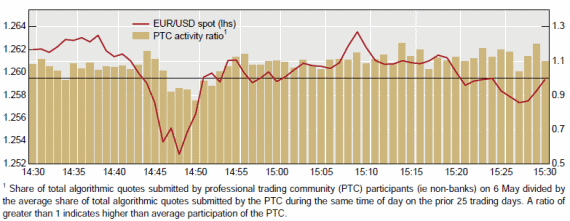While the report, called High-frequency trading in the foreign exchange market, acknowledged that the presence of HFTs has the potential to aggravate swings in market prices, the nature of HFT trading strategies made them very unlikely to be an initial trigger for a flash crash. Instead, the BIS’s Markets Committee concludes that systemic risk comes from what it calls “rogue” algorithmic trades rather than HFT activity per se, which tends to involve small trade sizes, short horizons and diverse strategies.
“Algorithms of HFT firms in FX are also less likely to be correlated than those in equity markets, and there is a higher propensity for HFTs to re-enter the market after unexpected downturns more quickly than traditional players,” says Guy Debelle, assistant governor of the Reserve Bank of Australia, who chaired the study group. “This actually has the potential to speed up a return to normal liquidity levels.”
Indeed, EBS data on algorithmic activity in EURUSD during the flash crash period on May 6, 2010, and the JPY move on March 17 this year, suggests that HFT activity may have increased rather than fallen, countering the assertion by market makers that HFT firms aren’t true liquidity providers in FX because when markets become volatile, they tend to disappear. The EBS data shows an increase in the average number of orders submitted per minute.
| Share of Algo activity on 6 May 2010 relative to prior period average |
 |
| Source: BIS, EBS |
The authors cited conversations with several FX prime brokerage providers who attested that HFT clients remained active during volatile periods. The suggestion is that the advanced risk management tools of HFT firms make them better equipped than most to deal with exceptional volatility. Where there is evidence that some HFTs did withdraw from the market, the group finds that the decline in activity was consistent with other market participants, as well as traditional liquidity providers who reduced activity and widened bid-ask spreads by as much as 100bps as volatility increased.
“Looking at the evidence suggests that the HFT behaviour during these times of extreme market stress was no different from that of virtually any other market player,” says Debelle.
The BIS report points out that the FX market has some basic underpinnings that do not exist in equity markets, making the likelihood of a flash crash-type event much lower. Principally, this is because there is natural demand for foreign exchange from cross-border trade and financial flows, as well as the ability for central banks to intervene with force.
Another fundamental difference is that foreign exchange is a relative price whereas a stock price is an absolute price, says the report. A price movement in a currency pair consists of a fall for one party but a rise for another. In this way FX price movements are really a redistribution of wealth rather than an outright reduction, as is the case when equity markets fall.
BIS and central banks want to increase oversight of HFT to better understand changing the market, but there is no sense that their presence is a source of instability requiring regulatory attention.
“On FX, we are comfortable with the issues being taken up by foreign exchange committees. We sit on these committees so we are happy to see how things play out there,” says Debelle. “It is largely a self-regulatory committee, and FX has relied on self regulation for a long time. There hasn’t been much wrong with that so far.”
That comes at a time when Wall Street brokerage regulator, the Financial Industry Regulatory Authority, has asked HFT firms to hand over details of trading strategies and, in some cases, their secret computer codes. The Securities and Exchange Commission has also begun making requests for proprietary algorithmic trading data.
The BIS report warns against over eagerness on the part of regulators, saying there is a lack of reliable data and analysis on the prevalence of HFTs.
“It is crucial to have a clearer understanding conceptually of what HFT is (and is not) and what it does (and does not do) before assessing the implications of HFT from a policymaker’s point of view,” the report concluded.



